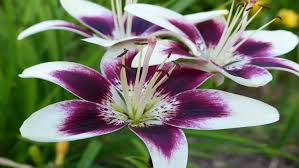Although there is a wide variety of beautiful flowers in the globe, the lily (Lilium spp.) stands out for its stunning beauty and enduring appeal. This article will take you on a journey into the interesting world of lily flowers, covering topics such as their significance, how they are grown, and the many different types that can be found in gardens.
A Brief History of Lilly Flowers
The delicate beauty and pleasant scent of lily blooms have enchanted people for generations. These blossoms have been historically significant to many different cultures. The ancient Egyptians used them religiously and saw in them a symbol of fertility and rebirth. Hera was the Greek goddess of motherhood and purity, and the lily was said to have sprung from her milk.
The Symbolism of Lilly Flowers
The symbolic meanings of lilies make them a popular option as both a gift and an ornamental flower. These are the most often cited alternatives:
1. Purity and Innocence
The white lily is a popular flower for weddings and religious ceremonies because it represents chastity and innocence.
2. Passion and Love
Red lilies are a beautiful gesture for conveying heartfelt feelings since they stand for passion and love.
3. Renewal and Rebirth
The lily is a sign of rebirth and fresh starts because of its close connection to spring.
The Diverse Species of Lilly Flowers
There are several species of lilies, and each has its own special allure. These are some of the most well-known animals:
1. Asiatic Lillies (Lilium asiatica)
These lilies are a popular among gardeners because of their beautiful hues and the ease with which they can be grown.
2. Easter Lillies (Lilium longiflorum)
The trumpet-shaped blooms of these Lillies are commonly connected with the Easter holiday.
3. Tiger Lillies (Lilium lancifolium)
Tiger lilies, so named for their spotted petals, are a popular addition to exotic-themed gardens.
Cultivating Lilly Flowers
Lily flowers are surprisingly simple to cultivate, making them a great option for gardeners of all skill levels. Essential cultivation advice, including:
1. Soil and Sunlight
For optimal development, lily bulbs should be planted in a sunny location with well-drained soil.
2. Watering
Water lily blossoms sometimes rather than constantly. The appropriate amount of irrigation is necessary to prevent bulb rot caused by overwatering.
3. Maintenance
Pruning and deadheading your flowers on a regular basis can extend their blooming time and keep your yard looking great.
The Timeless Elegance of Lilly Flowers
The beauty and grace of lily blooms never go out of style. Whether you’re drawn to them for their meaning or for aesthetics alone, these lovely flowers can brighten up any garden or bouquet.
Conclusion
Finally, Lilly flowers are more than a visual and sensual treat; they also have deep symbolic meaning in many cultures. Lily flowers are a wonderful addition to any garden because of their long history, wide variety of varieties, and ease of care. Why wait then? Allow the eternal beauty of lily blossoms to blossom in your heart.
FAQs (Frequently Asked Questions)
1. Can I grow Lilly flowers indoors?
Some types of Lilly may be cultivated successfully in containers when given enough light at home.
2. How do I prevent Lilly bulbs from rotting?
For healthy lily bulbs, make sure the soil drains well and doesn’t get too wet.
3. What is the best time to plant Lilly bulbs?
Before the first frost of the season is when you should plant your lily bulbs.
4. Are Lilly flowers toxic to pets?
If you have a cat, it’s best to keep the Lilly flowers out of reach.
5. Can I use Lilly flowers for medicinal purposes?
It is recommended to get the advice of a qualified herbalist or medical expert before using any Lilly species for therapeutic purposes.





